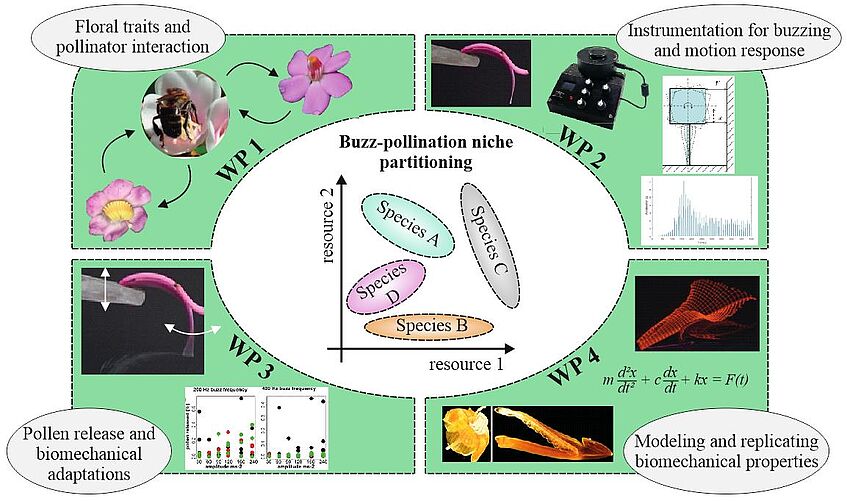Flower biomechanics and the buzz-pollination niche
- FWF-Project P 36766-B
- 2023/6 –
- Project leader: Ass.-Prof. Agnes Dellinger, BSc MSc PhD
- Cooperations: DI Dr. Ernst Csencsics (TU Wien)

© A. Dellinger
Decades of research on plant-pollinator interactions have shown that the large diversity of flowers has largely evolved in relation to different pollinators. Commonly, closely-related plant species pollinated by distinct functional pollinator groups (i.e., one species by bees, the other by hummingbirds) have been studied to understand the evolution of strikingly distinct flowers. In many plant groups, however, hundreds of species have evolved that are all pollinated by the same functional pollinator group (i.e., bees). Such plant groups can also show high flower diversity, but how flowers diversify in adaptation to the same functional pollinator group remains elusive.
Buzz-pollination by bees represents a pollination system where thousands of plant species are pollinated by bees. Pollen, which serves for plant reproduction and as pollinator reward, can only be released from these flowers when bees apply vibrations of specific frequencies and amplitudes. Many buzz-pollinated plants (i.e., tomatoes, potatoes, kiwis) exhibit the same flower type with reflexed petals and anthers (the male reproductive organs containing the pollen) forming a cone. In the large tropical plant family Melastomataceae, however, a much larger diversity of flowers has evolved, including both flowers with anther cones as well as flowers with complex arrangements of anthers and prominent anther appendages. To date, it remains unclear whether this flower diversity represents adaptations to different bee species, and which flower traits (e.g., scent, color, pollen rewards, flower-pollinator fit, biomechanical vibration properties of flower) differentiate to specialize on different bee species.
In our project, we combine approaches from pollination biology and flower evolution (Agnes Dellinger, University of Vienna) with methods from mechatronics (Ernst Csencsics, Vienna Technical University) to investigate how Melastomataceae flowers have adapted to buzz-pollinating bees. Together with Latin American colleagues, we will document plant-pollinator-interactions directly in the natural habitats of the plants in Latin America and employ artificial vibration experiments with a new vibration shaker table constructed by us. We will further investigate flowers ultrastructurally using µ-computed tomography and employ computer simulations and 3D-printing of flowers to replicate the biomechanical properties of these flowers. Our combination of pollination biological and mechatronic approaches allows us to explore both ecological interaction processes as well as principles of physics in biological structures. Since buzz-pollination occurs in approximately 10 % of flowering plants, including important crops, we expect our results to be relevant both for basic research as well as applications in agronomy.
